Feeding your Pitbull a raw diet can significantly enhance their health and vitality. Owners who transition their dogs to raw feeding often report noticeable improvements in coat shine, dental hygiene, energy levels, and overall digestion. As an expert on canine nutrition, particularly for robust breeds like Pitbulls, we understand the desire to provide the best possible diet. If you’re wondering “What Raw Meat Can I Feed My Pitbull,” this guide will walk you through the essential components of a balanced raw food regimen, offering practical meal ideas to ensure your beloved companion thrives.
The Benefits of a Raw Diet for Your Pitbull
A biologically appropriate raw food (BARF) diet, mimicking what canines would eat in the wild, brings a myriad of advantages for Pitbulls. Their strong jaws and digestive systems are well-suited to process raw ingredients. Beyond anecdotal evidence, many veterinary experts and experienced raw feeders observe consistent benefits:
- Improved Dental Health: Chewing raw meaty bones helps naturally scrape away plaque and tartar, promoting cleaner teeth and healthier gums, reducing the need for costly dental procedures.
- Shinier Coats and Healthier Skin: The natural fats, omega fatty acids, and essential nutrients in raw meat contribute to a lustrous coat and reduce skin issues like dryness, flakiness, or excessive shedding.
- Enhanced Energy and Stamina: A diet rich in natural proteins and fats provides sustained energy, ideal for the active and muscular Pitbull breed.
- Better Digestion and Nutrient Absorption: Raw foods are typically easier for dogs to digest, leading to smaller, firmer, and less odorous stools. The bioavailability of nutrients is also often higher.
- Stronger Immune System: A diet free from artificial additives, fillers, and highly processed ingredients can bolster the immune system, helping your Pitbull ward off illnesses.
- Weight Management: Raw diets can help maintain a healthy weight due to their high protein content and natural satiety, preventing obesity common with carbohydrate-heavy kibble.
Understanding the Core Components of a Balanced Raw Diet
A truly balanced raw diet for your Pitbull isn’t just about feeding raw meat; it’s about providing a variety of components in appropriate ratios. The general guideline for a balanced raw diet is often referred to as the “Prey Model Raw” (PMR) or “Biologically Appropriate Raw Food” (BARF) model, typically aiming for:
- Muscle Meat (70-80%): This forms the bulk of the diet, providing essential protein and amino acids.
- Raw Meaty Bones (10-15%): Crucial for calcium, phosphorus, and other minerals, as well as dental health. Bones should be raw and appropriate for your dog’s size – never cooked.
- Organ Meat (5-10%): These are nutrient powerhouses, especially liver (5%) and other secreting organs like kidney, spleen, or pancreas (2.5-5%). They provide vital vitamins and minerals.
- Fruits and Vegetables (0-10% for PMR, up to 15% for BARF): While not strictly necessary for all PMR purists, many BARF feeders include blended or pureed fruits and vegetables for added antioxidants, vitamins, minerals, and fiber.
- Supplements (As needed): Some raw feeders incorporate supplements like fish oil for omega-3s, probiotics for gut health, or joint support, especially for active or aging Pitbulls.
Safe Raw Meats and Proteins for Pitbulls
When considering “what raw meat can I feed my Pitbull,” variety is key to ensuring a broad spectrum of nutrients. Here are common and safe raw protein sources:
- Chicken: A staple for many raw feeders, providing muscle meat (breasts, thighs), organs (livers, hearts, gizzards), and raw meaty bones (backs, necks, wings, feet, leg quarters). Chicken is generally affordable and widely available.
- Beef: Excellent source of protein and iron. Options include ground beef, beef chunks, beef heart, beef liver, kidney, and meaty bones like ribs or neck.
- Turkey: Similar to chicken, offering various muscle meats (thighs, wings, drumsticks), organs, and raw meaty bones (necks, wings).
- Pork: Lean pork muscle meat is suitable. Pork organs (liver, kidney) are also nutritious. Ensure pork is sourced from reputable suppliers to minimize the risk of parasites. Avoid feeding wild boar.
- Lamb: A good alternative for dogs with sensitivities to other proteins. Lamb muscle meat, organs, and meaty bones are excellent.
- Fish: Oily fish like sardines, mackerel, herring, and anchovies are fantastic sources of omega-3 fatty acids, crucial for skin, coat, and brain health. Small whole fish can be fed, or larger fish can be cut into pieces. Salmon heads are also great.
Remember to source your raw meat from reputable suppliers that provide human-grade meat, or specifically labeled pet-grade raw food products.
Raw Meal Ideas for Your Pitbull: Beyond the Basics
To illustrate how to combine these components, here are enhanced raw meal ideas, providing a glimpse into the variety you can offer your Pitbull. Each meal balances muscle meat, organ meat, raw meaty bones, and beneficial additions.
Meal Idea #1: Beef & Chicken Combo with Greens & Joint Support
This meal features a robust base of ground beef for muscle meat, complemented by a chicken back for raw meaty bone content. Spinach adds vitamins and fiber, while anchovies and green-lipped mussels provide essential omega-3 fatty acids and natural joint support. A beef liver protein pack boosts organ meat intake, and additional berry and joint supplements enhance overall health.
 Balanced raw meal for Pitbull with ground beef, chicken back, spinach, and supplements
Balanced raw meal for Pitbull with ground beef, chicken back, spinach, and supplements
Meal Idea #2: Chicken & Fish Feast with Organ Variety
A comprehensive chicken mix provides muscle meat and some bone, enriched with mackerel for omega-3s. Chicken feet offer natural glucosamine and chondroitin. Beef liver and kidney supply crucial vitamins and minerals. A fruit and veggie mix, along with parsley, adds antioxidants and fiber, while pork tongue offers additional protein and texture.
 Raw chicken and organ meat meal with fish, chicken feet, and vegetables for Pitbulls
Raw chicken and organ meat meal with fish, chicken feet, and vegetables for Pitbulls
Meal Idea #3: Salmon & Quail Delight with Antioxidant Boost
This meal incorporates a salmon head, an excellent source of omega-3s and raw bone. Quail provides a novel protein source. Beef cheek offers muscle meat, and kefir introduces beneficial probiotics for gut health. Spring mix and frozen raspberries contribute a rich array of vitamins and antioxidants.
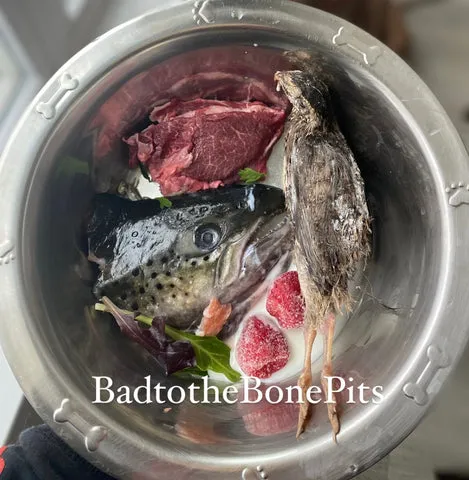 Nutrient-rich raw meal for Pitbull featuring salmon head, quail, beef cheek, and berries
Nutrient-rich raw meal for Pitbull featuring salmon head, quail, beef cheek, and berries
Meal Idea #4: Chicken & Seafood Medley with Egg
This chicken mix meal is enhanced with dehydrated chicken feet for chewing and joint benefits. A whole egg (with shell, if tolerated) provides complete protein and calcium. Spring mix serves as a garnish, while dehydrated whole prawns and anchovy heads boost omega-3s. Berry and joint supplements complete this nutrient-dense meal.
 Raw chicken mix meal for Pitbull with whole egg, seafood, and spring greens
Raw chicken mix meal for Pitbull with whole egg, seafood, and spring greens
Meal Idea #5: Beef & Duck Bone Meal with Essential Supplements
A beef mix forms the foundation, complemented by dehydrated duck head and duck foot for raw meaty bone content and chewing enrichment. Spinach provides greens, while anchovies and green-lipped mussels offer omega-3s and joint support. Berry and probiotic supplements ensure comprehensive nutritional coverage.
Meal Idea #6: Simple Chicken & Herring Meal
This meal focuses on a chicken mix, providing muscle meat and bone. Herring is added for its high omega-3 content. A fruit and veggie mix delivers essential vitamins and fiber, and a whole egg rounds out the meal with protein and healthy fats.
 Simple raw chicken meal for Pitbull with herring, fruit, and vegetables
Simple raw chicken meal for Pitbull with herring, fruit, and vegetables
Meal Idea #7: Ground Beef & Organ Richness with Whole Prey
Ground beef serves as the primary muscle meat. Whole prey chick offers a unique nutritional profile, including bone and organ content. Beef kidney and liver are essential for organ nutrient density. Dehydrated green-lipped mussels provide joint support, and parsley adds a touch of fresh vitamins.
 Raw ground beef and organ meat meal for Pitbull with whole prey chick and mussels
Raw ground beef and organ meat meal for Pitbull with whole prey chick and mussels
Meal Idea #8: Beef with Duck Bones & Digestive Support
Ground beef is paired with duck head and duck feet for crucial raw meaty bone intake. Beef kidney and pork liver ensure a good range of organ nutrients. Spinach adds greens, while joint and digestive supplements support overall mobility and gut health.
 Raw ground beef meal with duck head, duck feet, organ meats, and spinach for Pitbull
Raw ground beef meal with duck head, duck feet, organ meats, and spinach for Pitbull
Meal Idea #9: Turkey & Beef Combo with Quail Eggs & Herbs
Ground beef and a turkey drumstick provide a varied protein base. Parsley and mint leaves add fresh nutrients and aid digestion. Dehydrated green-lipped mussels and anchovies contribute omega-3s and joint support. Quail eggs offer a complete protein, and calf liver boosts essential organ nutrients.
 Raw turkey drumstick and ground beef meal for Pitbull with quail eggs and fresh herbs
Raw turkey drumstick and ground beef meal for Pitbull with quail eggs and fresh herbs
Meal Idea #10: Beef Mix with Capelin & Chicken Feet
A beef mix provides the primary muscle and bone component. Capelin, a small oily fish, is an excellent source of omega-3s. Chicken feet add a natural source of collagen and calcium. Blue spirulina is included for its antioxidant and anti-inflammatory properties.
 Raw beef mix meal for Pitbull with whole capelin fish and chicken feet
Raw beef mix meal for Pitbull with whole capelin fish and chicken feet
Meal Idea #11: Trachea & Tripe with Veggies & Fish
Beef trachea provides a fantastic chew and natural source of chondroitin. Green tripe is a highly digestible source of probiotics. A veggie mix, duck feet (for bone), ground beef, anchovies (for omega-3s), spinach, and beef liver complete this nutritionally diverse meal.
 Raw beef trachea and tripe meal with vegetables, duck feet, and anchovies for Pitbull
Raw beef trachea and tripe meal with vegetables, duck feet, and anchovies for Pitbull
Meal Idea #12: All Chicken & Sardines
This meal focuses on various chicken parts: chicken leg quarter (muscle and bone), chicken liver, chicken hearts (muscle meat and taurine), and chicken gizzards (muscle meat). Sardines are added for their rich omega-3 content.
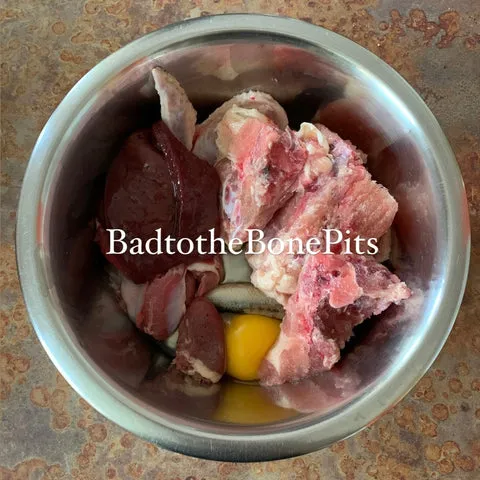 Raw chicken leg quarter meal for Pitbull with chicken organs and sardines
Raw chicken leg quarter meal for Pitbull with chicken organs and sardines
Meal Idea #13: Chicken Breast & Turkey Head with Yogurt & Parsley
Chicken breast offers lean muscle meat. A dehydrated turkey head provides a substantial raw meaty bone. Beef kidney and chicken liver ensure organ nutrient balance. Smelt offers omega-3s, while egg (with shell) and plain Greek yogurt add protein, calcium, and probiotics. Parsley provides fresh vitamins.
 Raw chicken breast and turkey head meal for Pitbull with organ meats and yogurt
Raw chicken breast and turkey head meal for Pitbull with organ meats and yogurt
Meal Idea #14: Chicken Mix with Organ Meats & Kelp
This chicken mix is enriched with beef kidney and beef liver for comprehensive organ support. Egg adds protein and fat. Mint leaves add freshness and digestive aid. Kelp provides a natural source of iodine and other trace minerals. A fruit and veggie mix, along with a joint supplement, boosts overall health.
 Raw chicken mix for Pitbull with beef kidney, liver, egg, mint, kelp, and vegetables
Raw chicken mix for Pitbull with beef kidney, liver, egg, mint, kelp, and vegetables
Meal Idea #15: Ground Beef with Chicken Heads & Bee Pollen
Ground beef is paired with chicken head and chicken feet for raw meaty bones. Smelt and green-lipped mussels provide omega-3s and joint benefits. Bee pollen is included for its immune-boosting properties and rich nutrient profile. Calf liver ensures adequate organ meat. A berry supplement adds antioxidants.
 Raw ground beef meal for Pitbull with chicken heads, bee pollen, smelt, and mussels
Raw ground beef meal for Pitbull with chicken heads, bee pollen, smelt, and mussels
Meal Idea #16: Pork & Turkey with Organ Variety & Berries
Ground pork and a turkey wing offer a balanced protein base. Beef heart adds vital nutrients and muscle meat. Beef liver and quail eggs provide a rich source of vitamins and protein. Blueberries add antioxidants, parsley provides fresh vitamins, and dehydrated green-lipped mussels support joint health.
 Raw pork and turkey wing meal for Pitbull with beef heart, liver, quail eggs, and berries
Raw pork and turkey wing meal for Pitbull with beef heart, liver, quail eggs, and berries
Meal Idea #17: Chicken Mix with Fish & Probiotic Boost
This chicken mix meal is enhanced with chicken feet for bone and anchovies for omega-3s. Quail eggs add complete protein. A fruit and veggie puree provides easily digestible nutrients. Plain Greek yogurt mixed with turmeric offers probiotics and anti-inflammatory benefits.
 Raw chicken mix meal for Pitbull with chicken feet, anchovies, quail eggs, and turmeric yogurt
Raw chicken mix meal for Pitbull with chicken feet, anchovies, quail eggs, and turmeric yogurt
Meal Idea #18: Ground Beef & Pork Ribs with Fruits & Veggies
Ground beef and pork ribs provide muscle meat and raw meaty bones. Smelt, mussels, and bee pollen offer essential fatty acids and immune support. A lamb liver protein pack boosts organ nutrients. Blue spirulina is added for antioxidants. Egg, tomato, lettuce, and strawberry complete the meal with a diverse range of vitamins and fiber.
Meal Idea #19: Ground Beef & Duck Heads with Organ Meats
Ground beef forms the primary protein source. Duck heads are included for their raw meaty bone content. Beef kidney and beef liver ensure a balanced intake of vital organ nutrients. Quail eggs add protein and healthy fats, while green-lipped mussels provide omega-3s and joint support.
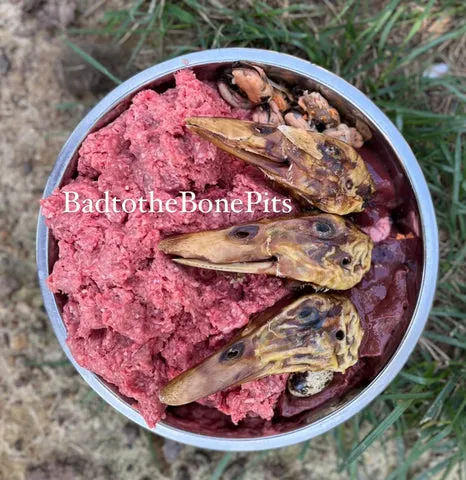 Raw ground beef meal for Pitbull with duck heads, organ meats, quail eggs, and green lipped mussels
Raw ground beef meal for Pitbull with duck heads, organ meats, quail eggs, and green lipped mussels
Meal Idea #20: Ground Beef & Turkey Gizzards with Multiple Organs & Bones
Ground beef is paired with turkey gizzards for muscle meat. Beef lung, kidney, and liver offer a comprehensive organ profile. Anchovies provide omega-3s, while duck head and duck feet contribute raw meaty bone. Blue spirulina adds an antioxidant boost.
 Raw ground beef, turkey gizzards, and varied organ meat meal for Pitbull with duck bones
Raw ground beef, turkey gizzards, and varied organ meat meal for Pitbull with duck bones
Meal Idea #21: Ground Beef & Chicken Heads with Egg & Varied Organs
Ground beef is a foundational protein. Chicken heads and an egg with shell provide raw meaty bone and calcium. Beef kidney, beef lung, turkey gizzards, and beef liver ensure a rich supply of organ nutrients. Kelp and blue spirulina offer trace minerals and antioxidants, while anchovies add omega-3s.
 Raw ground beef meal for Pitbull with chicken heads, egg, various organs, kelp, and spirulina
Raw ground beef meal for Pitbull with chicken heads, egg, various organs, kelp, and spirulina
Meal Idea #22: Ground Beef & Chicken Necks with Kale & Digestive Aid
Ground beef and chicken necks (for bone and muscle) are combined. Kale adds essential vitamins and fiber. Bee pollen boosts immunity. Beef kidney and beef liver provide vital organ nutrients. Slippery elm bark is included for digestive support, and fish skin offers collagen and healthy fats.
 Raw ground beef and chicken neck meal for Pitbull with kale, bee pollen, and slippery elm bark
Raw ground beef and chicken neck meal for Pitbull with kale, bee pollen, and slippery elm bark
Meal Idea #23: Ground Beef & Pork Ribs with Berries & Organ Mix
Ground beef and pork ribs provide a hearty base of muscle meat and raw meaty bone. Capelin adds omega-3s. Spring mix, blueberries, raspberries, and blackberries offer a powerful blend of antioxidants and vitamins. Beef kidney and calf liver ensure a comprehensive intake of organ nutrients.
 Raw ground beef and pork ribs meal for Pitbull with mixed berries, spring mix, and organ meats
Raw ground beef and pork ribs meal for Pitbull with mixed berries, spring mix, and organ meats
Meal Idea #24: Turkey Gizzards & Chicken Heads with Fruits & Organs
Turkey gizzards provide robust muscle meat. Green-lipped mussels add joint support. Kale and strawberries contribute vitamins and antioxidants. Anchovies are included for omega-3s. Chicken heads offer raw meaty bone. Beef liver and beef kidney ensure essential organ nutrient intake.
 Raw turkey gizzards and chicken heads meal for Pitbull with kale, strawberries, and organ meats
Raw turkey gizzards and chicken heads meal for Pitbull with kale, strawberries, and organ meats
Meal Idea #25: Ground Beef & Duck Heads with Berries & Organ Variety
Ground beef and duck heads (for raw meaty bone) are combined. Anchovies provide omega-3s. Strawberries and kale offer antioxidants and vitamins. Beef kidney, beef liver, and green-lipped mussels ensure a balanced nutrient profile.
 Raw ground beef and duck heads meal for Pitbull with berries, kale, and organ meats
Raw ground beef and duck heads meal for Pitbull with berries, kale, and organ meats
Meal Idea #26: Ground Beef & Duck Feet with Organ Meats & Berries
Ground beef is paired with duck feet for raw meaty bone content. Turkey gizzards add muscle meat. Anchovies and green-lipped mussels contribute omega-3s and joint support. Strawberries and kale provide vitamins and fiber. Beef kidney and beef liver ensure a complete organ meat profile.
 Raw ground beef meal for Pitbull with duck feet, turkey gizzards, berries, and organ meats
Raw ground beef meal for Pitbull with duck feet, turkey gizzards, berries, and organ meats
Meal Idea #27: Ground Beef & Chicken Heads with Mixed Berries & Egg
Ground beef and chicken heads (for raw meaty bone) form the base. Capelin adds omega-3s. Blackberries, blueberries, and raspberries provide a powerful antioxidant boost. A whole egg (with shell) offers complete protein and calcium. Spring mix adds greens. Beef kidney and calf liver complete the organ meat portion.
 Raw ground beef and chicken heads meal for Pitbull with mixed berries, egg, and organ meats
Raw ground beef and chicken heads meal for Pitbull with mixed berries, egg, and organ meats
Meal Idea #28: Chicken Necks & Turkey Gizzards with Digestive Support & Fish Skin
Chicken necks and turkey gizzards provide a mix of raw meaty bone and muscle meat. Duck foot adds extra bone. Kale contributes vitamins. Bee pollen supports immunity. Beef kidney and beef liver provide essential organ nutrients. Fish skin offers collagen and healthy fats, while slippery elm bark aids digestion.
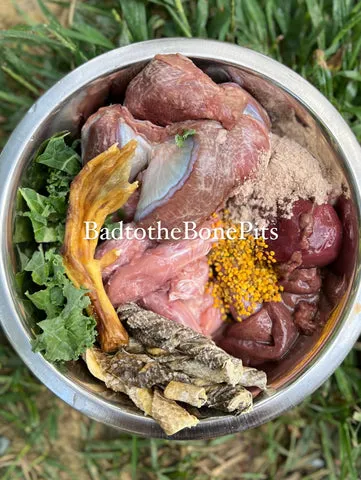 Raw chicken necks and turkey gizzards meal for Pitbull with duck foot, kale, and fish skin
Raw chicken necks and turkey gizzards meal for Pitbull with duck foot, kale, and fish skin
Meal Idea #29: Chicken Organs & Backs with Fish & Berries
Chicken gizzards and chicken backs provide a good mix of muscle meat and raw meaty bone. Anchovies are included for omega-3s. Blueberries and raspberries add antioxidants. Calf liver ensures a crucial source of organ nutrients.
 Raw chicken gizzards, chicken backs, anchovies, blueberries, raspberries, and calf liver for a Pitbull's diet
Raw chicken gizzards, chicken backs, anchovies, blueberries, raspberries, and calf liver for a Pitbull's diet
Meal Idea #30: Ground Beef & Pork Ribs with Organ Meats & Berry Garnish
Ground beef and pork ribs offer a hearty muscle and bone base. Green-lipped mussels add joint support. Beef kidney and beef liver provide essential organ nutrients. Blueberries, raspberries, and a spring mix garnish complete the meal with antioxidants and fresh vitamins.
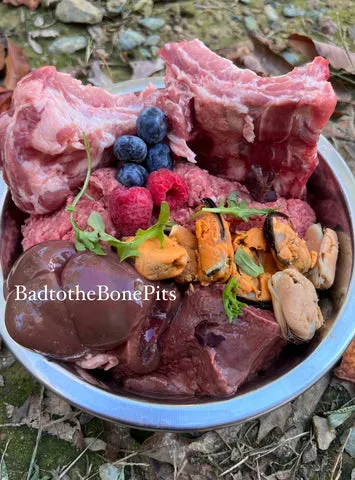 Raw ground beef and pork ribs meal for Pitbull with organ meats, berries, and greens
Raw ground beef and pork ribs meal for Pitbull with organ meats, berries, and greens
Meal Idea #31: Chicken Organs & Duck Feet with Egg & Berries
Chicken gizzards provide muscle meat. Duck feet offer raw meaty bone and collagen. Fish skin contributes healthy fats. Beef liver ensures organ nutrient intake. A whole egg with shell adds protein and calcium. Raspberries and blueberries provide antioxidants.
 Raw chicken gizzards, duck feet, fish skin, beef liver, egg with shell, raspberries, and blueberries for a Pitbull's diet
Raw chicken gizzards, duck feet, fish skin, beef liver, egg with shell, raspberries, and blueberries for a Pitbull's diet
Meal Idea #32: Chicken Leg Quarters & Smelt with Organ Meats & Quail Eggs
Chicken leg quarters provide both muscle meat and raw meaty bone. Smelt is an excellent source of omega-3s. Beef kidney and chicken liver ensure balanced organ nutrients. Raspberries add antioxidants, and quail eggs contribute complete protein.
 Raw chicken leg quarters, smelt, beef kidney, chicken liver, raspberries, and quail eggs, a balanced meal for Pitbulls
Raw chicken leg quarters, smelt, beef kidney, chicken liver, raspberries, and quail eggs, a balanced meal for Pitbulls
Meal Idea #33: Ground Beef & Pork Ribs with Organ Meats & Supplements
Ground beef and pork ribs offer muscle meat and raw meaty bone. Beef kidney and beef liver provide essential organ nutrients. Kelp and bee pollen are included for trace minerals and immune support. Green-lipped mussels add joint support, and mackerel head contributes omega-3s and raw bone.
 Raw ground beef and pork ribs meal for Pitbull with organ meats, kelp, bee pollen, mussels, and mackerel head
Raw ground beef and pork ribs meal for Pitbull with organ meats, kelp, bee pollen, mussels, and mackerel head
Meal Idea #34: Ground Chuck & Chicken Drumsticks with Organ Meats & Fish
Ground chuck and chicken drumsticks provide a hearty blend of muscle meat and raw meaty bone. Mackerel head is an excellent source of omega-3s and raw bone. Beef kidney and chicken liver ensure a balanced intake of vital organ nutrients.
 Raw Ground Chuck, Chicken Drumsticks, Mackerel Head, Beef Kidney, Chicken Liver, a complete raw food recipe for Pitbulls
Raw Ground Chuck, Chicken Drumsticks, Mackerel Head, Beef Kidney, Chicken Liver, a complete raw food recipe for Pitbulls
Important Considerations for Raw Feeding Pitbulls
While raw feeding offers many benefits, it’s crucial to approach it with knowledge and care:
- Consult Your Veterinarian: Always discuss dietary changes with a vet, especially one experienced in canine nutrition or raw feeding. They can offer personalized advice based on your Pitbull’s specific health needs.
- Sourcing and Quality: Purchase raw ingredients from reputable sources. Ensure the meat is fresh, human-grade, or specifically processed for pet consumption, to minimize risks of bacterial contamination.
- Safe Handling: Practice strict hygiene when handling raw meat to prevent contamination for both your dog and your household. Clean all surfaces, bowls, and utensils thoroughly.
- Balance is Key: While these meal ideas provide examples, remember that variety over time ensures nutritional balance. Don’t aim for perfect balance in every single meal, but rather over weeks or months.
- Introducion and Transition: Introduce raw foods gradually, especially if your Pitbull is currently on a kibble diet, to allow their digestive system to adjust.
- Bone Safety: Always feed raw, appropriately sized bones. Never feed cooked bones, as they can splinter and cause serious harm. Monitor your dog while they eat bones.
- Storage: Store raw food properly frozen and thaw in the refrigerator.
Conclusion
Transitioning your Pitbull to a raw diet can be a highly rewarding experience, offering significant improvements in their health and well-being. By understanding “what raw meat can I feed my Pitbull” and focusing on a balanced approach that includes muscle meat, organ meat, raw meaty bones, and beneficial supplements, you can provide a diet that aligns with their natural biological needs. These meal ideas serve as an excellent starting point, demonstrating the variety and nutritional richness possible within a raw feeding regimen. Always prioritize sourcing quality ingredients and practicing safe handling.
For further insights into the benefits and practicalities of raw feeding, we encourage you to explore more about why we feed a raw food diet and delve into our raw food starter guide. Empower yourself with knowledge to give your Pitbull the healthiest life possible!
References
- American Veterinary Medical Association (AVMA). Raw or Undercooked Animal-Source Protein in Cat and Dog Diets. (Hypothetical reference for safety guidelines)
- Board on Agriculture and Natural Resources, National Academies of Sciences, Engineering, and Medicine. (2006). Your Dog’s Nutritional Needs: A Science-Based Guide for Dog Owners. The National Academies Press.
- Association of American Feed Control Officials (AAFCO). Pet Food Nutrient Profiles. (Hypothetical reference for nutritional requirements)
- The World Small Animal Veterinary Association (WSAVA) Global Nutrition Guidelines. (Hypothetical reference for expert opinion on diet)
